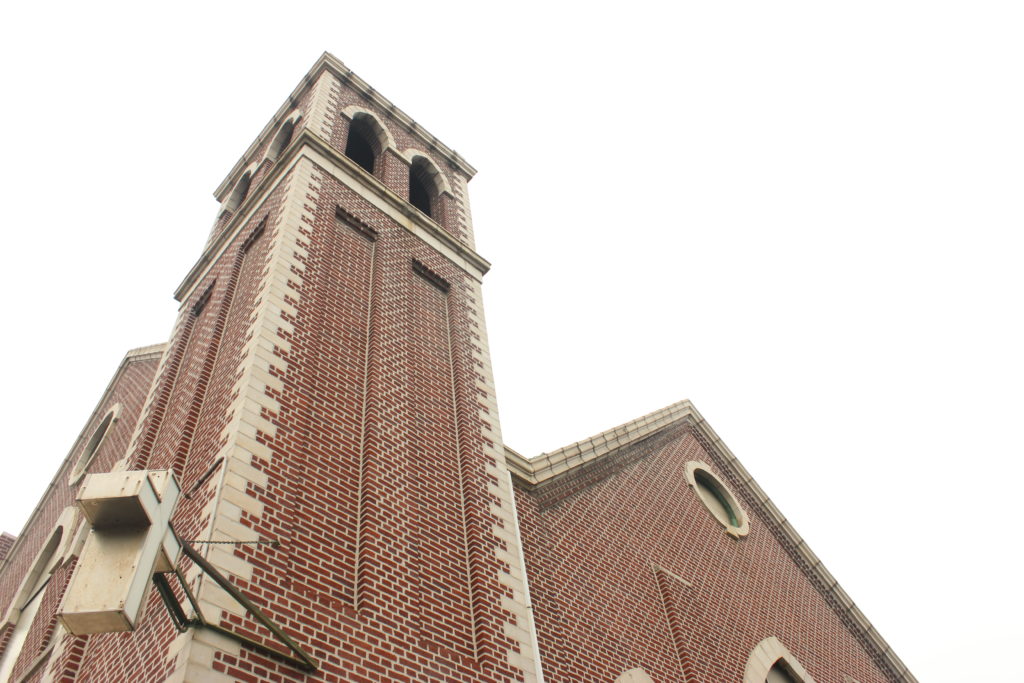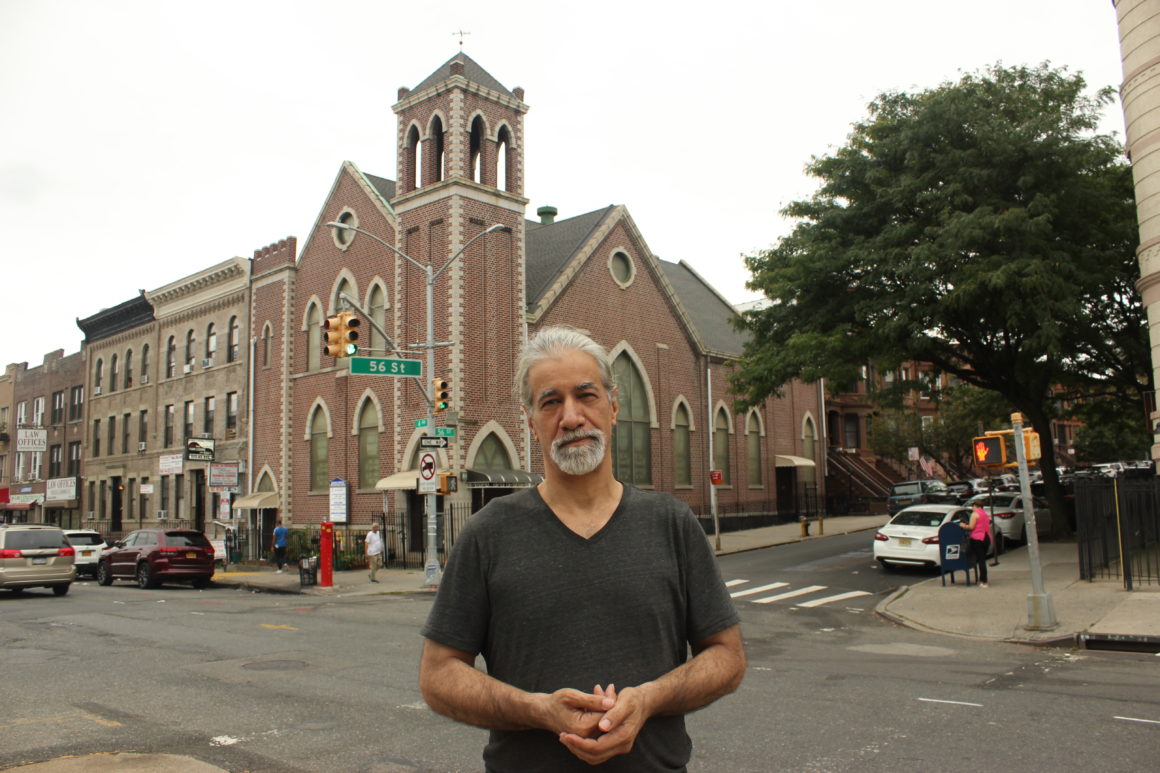Around three years ago, Harry Mena, 58, a filmmaker and longtime Sunset Park resident, began a project he called “Sunset Park Railroad.” The project was conceived with Mena asking himself a question: “What are the stories we don’t see? Who’s invisible?” he said. “I celebrate our elders, immigrants, and our humanity by presenting the images that we never, hardly ever see in the mainstream culture.”
He would do so with art. “Sunset Park Railroad” aspires to install several installations across the neighborhood. The first will be a mural of words of welcome, which will hang on the bell tower of the Bethelship Norwegian United Methodist Church, on 56 St. and Fourth Ave. The words are aimed at the neighborhood’s many immigrants.
The mural may come at just the right time, as in the recent months, according the news channel PIX1, Sunset Park was the most-targeted area in the city for raids by ICE, with four of the eight ICE raids that took place in New York City back in the summer.

And the mural may have found just the right home, too. The Bethelship Church bears the footprints of the many of the immigrants who have walked over Brooklyn for more than a hundred years. With the construction of a pro-immigrant mural, the church promises to deliver a welcoming message to its community.
History repeats itself in this neighborhood, as nearly ninety years ago, Norwegian immigrants were also the target of ICE-like raids. According to the Brooklyn Daily Eagle, a daily newspaper that circulated until 1963, in Apr. 22, 1932, “Ten Norwegian immigrants living in Bay Ridge, were in the hands of the Federal authorities, charged with having entered this country illegally.”
Mena, whose parents are Puerto Rican, says that the mural is “going to be a huge moment because it’s going to deliver our message to the world,” he said. And that people will be able to see that “This land is our land.”
Once part of Bay Ridge, Sunset Park has been the home of immigrants for centuries.
Its demographics have changed over time. According to an archived issue of the Daily Eagle from 1925, the Norwegian immigrant population was prevalent in the U.S., with 1.7 million having crossed the pond to reach the Statue of Liberty. Around that same time, roughly forty-five thousand Norwegians lived in Brooklyn.
They kept coming, Erling Dugan, 66, emigrated from Norway with his large family in 1959 to Sunset Park. Though, he lives in the South West Coast of Norway, he comes back to Sunset Park often, and administers a Facebook group called “Brooklyn Norwegians.” Dugan describes Sunset Park’s Eighth Ave. as a little Norway, filled with Norwegian stores, food, and people speaking the language.
Things began to change in the late sixties, when Puerto Ricans started to move to Sunset Park. And Eighth Ave. has changed, now with the dominating presence of Chinese immigrants.
“In Brooklyn a neighborhood changes every twenty years,” Dugan said. When the Puerto Rican population moved in, “Norwegians moved somewhere else.” As the Scandinavian country discovered oil in the North Sea and its economy bloomed, Dugan and his family moved back to Norway in the early seventies. As the Norwegians moved out and new waves of immigrants from other countries and territories installed themselves in Sunset Park, signs of the Norwegians remained. The Bethelship Church is one of them.
Today, Dugan says there are not many signs that the church was once built by Norwegians. One of the few indicators is the church’s name, which, according to Dugan, translates from Norwegian as “the house of God.” Another one is a painting of the original ship, which still hangs. It is the Bethelship, and that comes with a story.
Brooklyn’s Daily Eagle writes that in 1963 the church came together as a mission to Scandinavian seamen coming into the port of New York, and a former Swedish seaman was concerned “for the spiritual welfare of men who had no place to go when in port but to the taverns and brothels.”
According to the Daily Eagle, the Bethelship community started in 1845 with a small, “second-hand” ship, which was fitted for religious services and was “docked in the North River,” an alternate name for the Hudson river around NYC. Subsequently, a second ship was purchased and then it “was moved from its mooring place in the North River to the foot of Harrison St. in Brooklyn, in the late 1860s.” In 1891, with gifts of $10,000 dollars, the Norwegian members of the church were able to purchase the current building, even as they were moving out of Bay Ridge.
The church is now used by different groups of people. “The main group now in Bethelship are people from India and that’s the result of Methodists having missionary work in India,” Dugan said.
Mena, who started the “Sunset Park Railroad” project, said that choosing the Bethelship church for the first installment of the art project was important as it may open further opportunities for the other tentative installations. As of October 2019, the “Sunset Park Railroad” official website identifies 10 potential spots for their installations.
Four different artists, whose walks of life and cultural backgrounds are distinct, will contribute to the Bethelship with their four different writing styles and artistic expression.
“This mural of words is an opportunity to see this community reflected in each of our artists, that each represent the demographic history of this community,” Mena said.
Huang Xiang, 77, poet and calligrapher, fled China after enduring persecution and torture, and will take charge of the Chinese calligraphy. Maria Domiguez, 68, a muralist, will bring her experience with murals, as she has commissioned several for the city. Samar Suleiman, 30, a Palestinian artist, is dexterous in Arabic calligraphy. And Lise Lorentzen, 51, an artist who practices Rosemåling, (Norwegian painting and decorative folk art), whose family and ancestors are Norwegian immigrants, will also be contributing.

Lorentzen, a third generation American-Norwegian, explained the importance of her participation in the project, saying that it has a “tie to the past because hundred years from now, it’s going to change again, fifty years it’s going to change again. Having this as the first of stations, you have that tie to the past and as you go to other stations, you tie to the present and you tie to the future.” Her designs for the mural say “peace, love, and unity” and she says that it will in Norwegian, Gujarati, and English.
The mural is planned to include nine languages in all, Spanish, Norwegian, Arabic, and Chinese among others. The project’s website states that its mission “will bring us all together to crash through walls of hatred, misogyny, and bigotry with a thing of beauty made here in the USA by amazing people from around the world.”


Leave a Reply